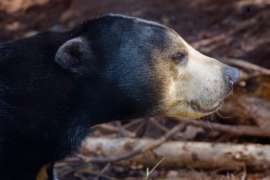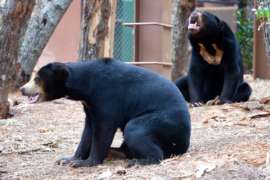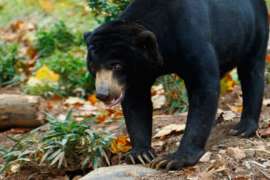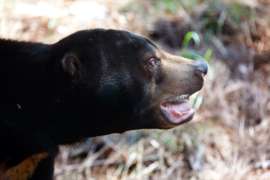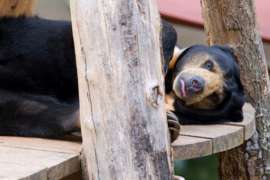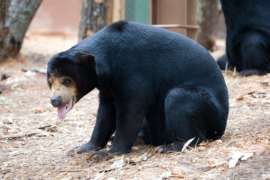Malayan Sun Bear
Malayan Sun Bear
These highly arboreal bears have exceptionally long claws and tongues to help them forage for honey, insects, and other small creatures inside logs. The name “sun bear” comes from the distinctive golden colored patch of fur on their chests, and every individual sun bear has a different patch. Commercial production of palm oil, as well as heavy poaching pressure for traditional medicines, are significant threats to this species.
Helarctos malayanus
Omnivore
Southeast Asia [VIEW MAP]
Forests
Sun bears spend their days alternately sleeping or roaming in constant search for food. At any given time on warm-weather days, you may see either of these activities. When foraging, they tirelessly explore every nook and cranny available. To encourage these natural behaviors, their habitat includes logs and other objects for them to explore and tear apart. As part of our sun bear enrichment program, keepers often hide food in logs or puzzle feeders. Be sure to look upwards, as these bears can often be seen napping at the top of their climbing structures.
Photos and Videos
Sun bears are the smallest of the eight species in the bear family. Their name comes from the light patch of fur on their chest, which legend says resembles the rising or setting sun. This patch of fur is uniquely patterned for each individual, much like a human’s fingerprints. Due to their inward-facing feet, sun bears have a distinctive pigeon-toed walk which serves as a clue to their arboreal lifestyle. These bears are primarily nocturnal and frequently spend their time during the day resting or sunbathing in trees, sometimes even on platforms they make out of branches and leaves. Females are known to walk erect cradling their cubs in their arms for short distances; this is one of only three bear species known to have this behavior. Sun bears are also called basindo nan tenggil in the Malay language, meaning “he who likes to sit high.” Other names include Malay bear, dog bear and honey bear. Unlike many other bear species, sun bears do not hibernate. As sun bears occur in tropical regions with food available year-round, they do not hibernate. Sun bears have the longest tongues of all bears. Sun bears have loose skin around their necks, which allows them to turn and bite attackers (most commonly clouded leopards, tigers, and other sun bears).
Sun bears have dark brown or brown-black fur with white, yellow, or light orange fur on their muzzles, around their eyes, and in a crescent or bib-shaped patch on their chest. Their coats are short to avoid overheating in tropical weather but are also coarse and thick to provide protection from rain and branches.
Sun bears are 3.5 to 4.5 feet long and can weigh 60 to 180 pounds, with females typically 10 to 20 percent smaller than males. These bears have a muscular, stocky build, with a short muzzle and rounded ears.
Sun bears have the longest tongues in the bear family at 8 to 10 inches long. Long, sickle-shaped claws on all four paws can exceed four inches in length and help the bears tear into trees and termite mounds. Their teeth are flatter than those of most other bears, and the canines are long enough to stick out between their lips.
Sun bears are polyestrous, meaning they do not have a defined “breeding season,” as the females may come in to estrus up to three times per year. Sun bears are solitary with the exception of a mother raising cubs. They reach reproductive maturity when they are 3 to 5 years old.
Nests have been observed in lush vegetation on the ground or in hollow logs. After a gestation of 95 to 100 days, females can give birth to one to three cubs, though typically they have litters of two. There is evidence of delayed implantation, with gestation in some zoos lasting as long as 230 to 240 days.
Newborn cubs weigh 7 to 12 ounces and are born blind, hairless and completely dependent on their mothers for warmth, protection and food. Cubs are able to play and move about on their own by the time they are 2 months old and are weaned by the time they are about a year old. They may stay with their mothers for up to three years.
The lifespan of sun bears in the wild is unknown, but in zoological settings, can exceed 30 years.
Sun bears spend their days alternately sleeping or roaming in constant search for food. At any given time on warm-weather days, you may see either of these activities. When foraging, they tirelessly explore every nook and cranny available. To encourage these natural behaviors, their habitat includes logs and other objects for them to explore and tear apart. As part of our sun bear enrichment program, keepers often hide food in logs or puzzle feeders. Be sure to look upwards, as these bears can often be seen napping at the top of their climbing structures.
Southeast Asia from southern China to eastern India and as far south as Indonesia
Dense lowland forests including tropical evergreen rainforests and seasonally dry forests
Like most bear species, sun bears are true omnivores, taking small vertebrates such as lizards, birds, and rodents, in addition to fruits, berries, insects, eggs, termites, bee nests, honey, young tips of palm trees, sprouts, tubers, roots, and even sap from trees. At the Zoo, we offer them a commercially manufactured omnivore pellet, in addition to a similarly broad diet of a variety of fruits and vegetables, including carrots, whole corn, romaine lettuce, bananas, apples and oranges. They are also offered beef knuckle bones weekly for enrichment and dental health benefits.
Zoo Atlanta is committed to helping find solutions to the ongoing threats of unsustainable palm oil production in places such as southeastern Asia. Finding less destructive ways to produce palm oil and other products will greatly benefit many species, including the Malayan sun bear.

